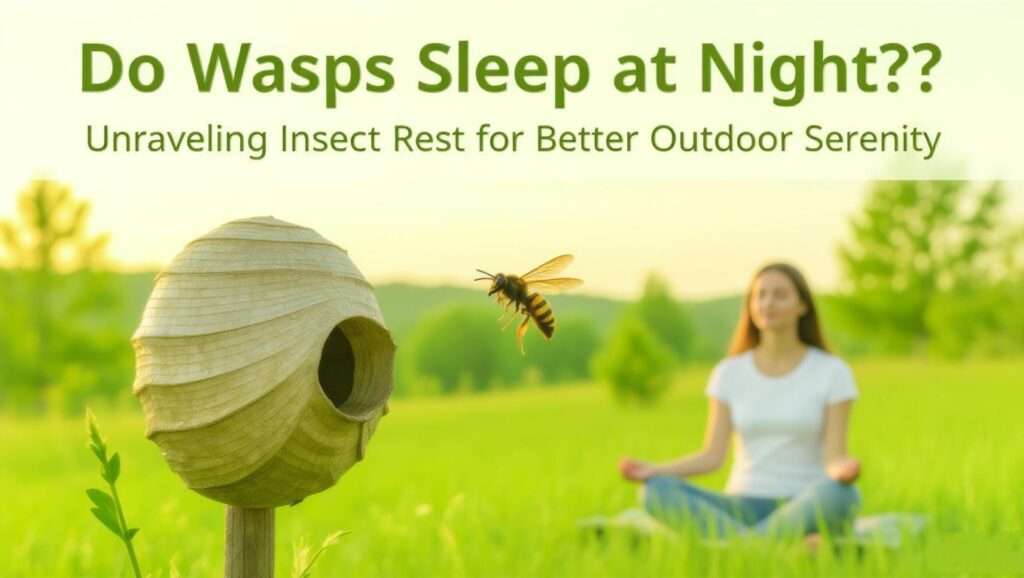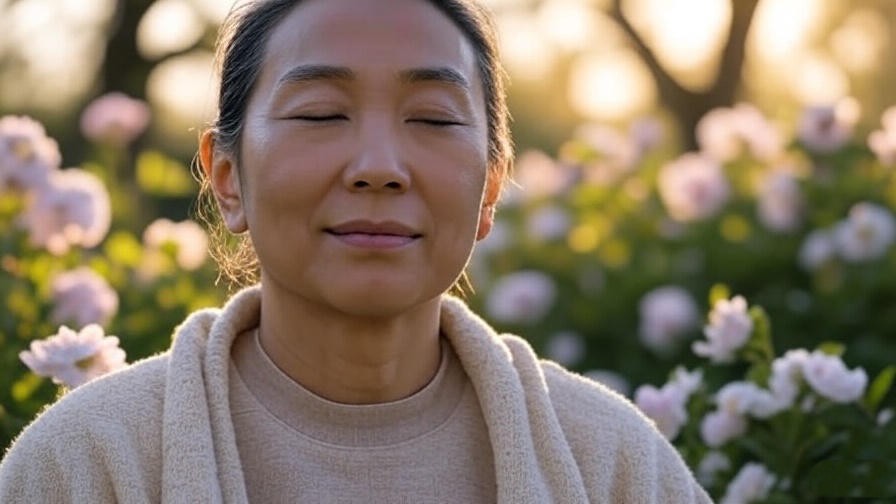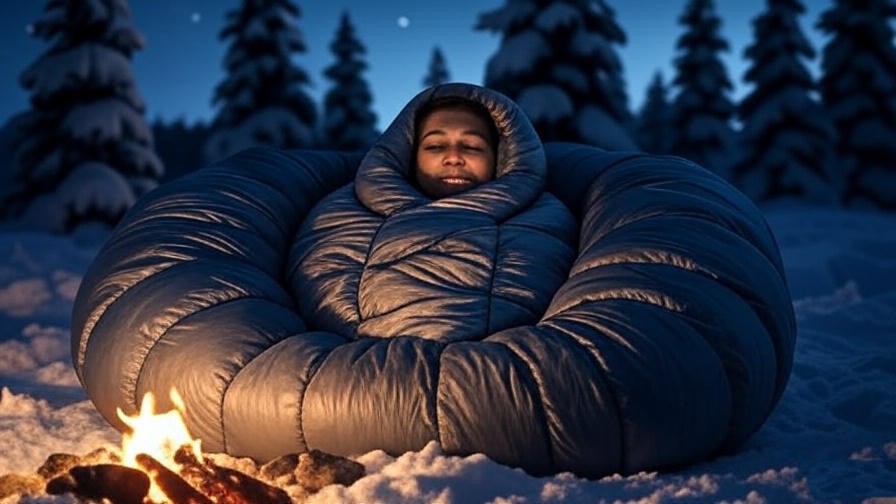Picture this: you’re unwinding in your backyard, the stars twinkling above, a gentle breeze carrying the scent of blooming flowers. Suddenly, a faint buzz disrupts your peace. A wasp. Your heart races—will it sting? Do wasps sleep at night, or are they always on patrol, ready to invade your tranquil evening? If you’ve ever wondered about the nighttime habits of these striped insects, you’re not alone. Understanding whether wasps sleep at night can transform your outdoor experience, reducing stress and fostering a deeper connection with nature. As experts in holistic well-being and nature-based mindfulness, we’ve delved into entomological research to bring you science-backed answers and practical tips. This article explores wasp behavior, their rest patterns, and how this knowledge can enhance your evenings, aligning perfectly with your journey toward serenity and happiness.
Understanding Wasp Behavior: Do Wasps Really Sleep?
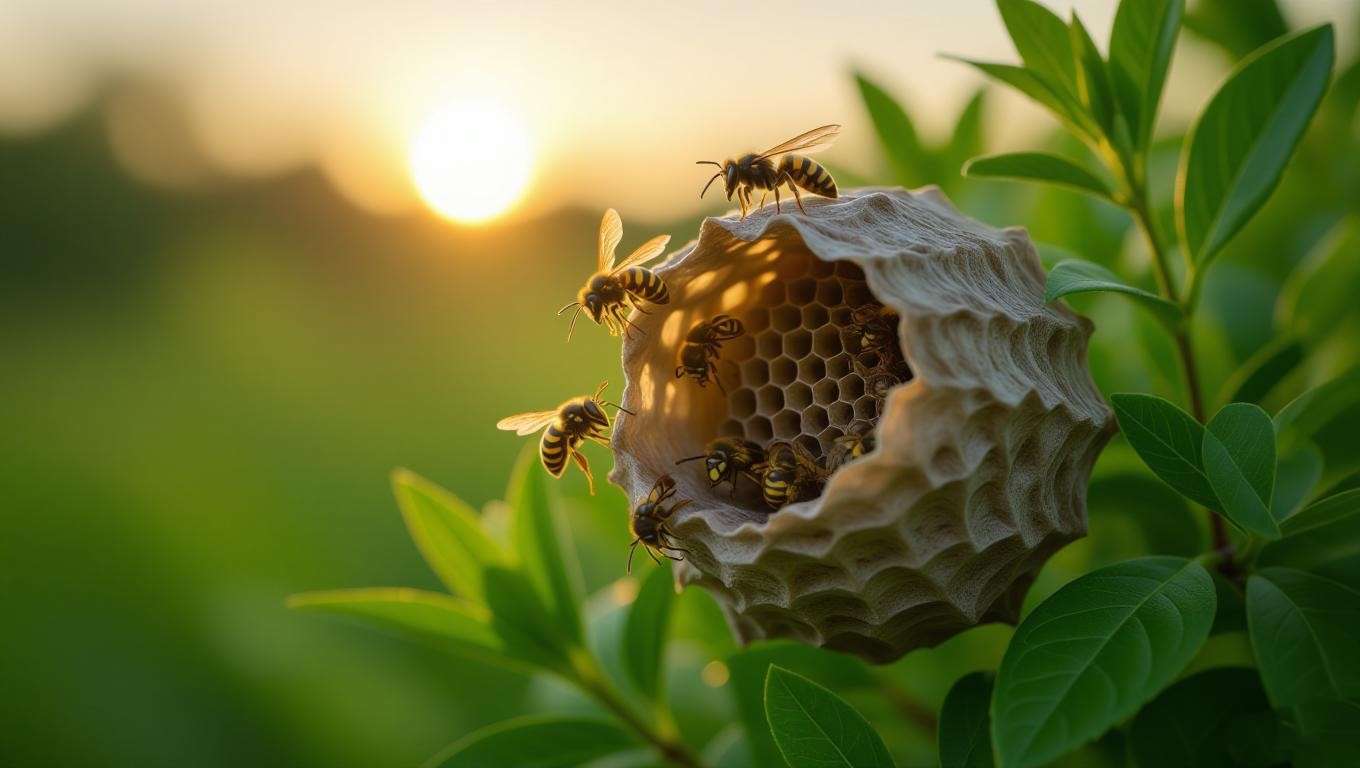
What Does “Sleep” Mean for Insects?
When we think of sleep, we envision cozy beds and REM cycles, but for insects like wasps, “sleep” is a different story. Entomologists describe insect rest as a state of torpor—a period of reduced activity where metabolic processes slow, conserving energy. Unlike human sleep, which involves complex brain activity, wasp rest is simpler but still governed by circadian rhythms, the internal clocks that sync with day and night. Research from the University of Arizona highlights that insects, including wasps, exhibit daily cycles of activity and rest, influenced by light and temperature. This foundational understanding sets the stage for unraveling whether wasps are active or dormant after sunset.
Do Wasps Sleep at Night? The Science Explained
So, do wasps sleep at night? The short answer is yes, but it’s not sleep as we know it. Most wasp species, particularly social wasps like yellowjackets and paper wasps, are diurnal, meaning they’re active during the day. At night, they enter a state of torpor, where they remain still, typically inside their nests. A 2018 study published in Insect Biochemistry and Molecular Biology found that wasps reduce their activity significantly after dusk, driven by circadian cues like diminishing light. Their brains release compounds similar to melatonin, signaling rest. However, certain environmental factors, like artificial lighting, can disrupt this cycle, occasionally causing minimal nighttime activity. For most backyard scenarios, though, wasps are unlikely to bother you after dark.
Why This Matters for Your Well-Being
Knowing that wasps sleep at night—or at least rest—can profoundly impact your outdoor experience. Evening gatherings are often synonymous with relaxation, meditation, or quality time with loved ones. The fear of a wasp sting can disrupt this serenity, triggering stress that clashes with holistic well-being. By understanding that wasps are generally inactive at night, you can plan outdoor activities with confidence, fostering mindfulness and a deeper connection to nature. This knowledge empowers you to reclaim your evenings, aligning with the principles of happiness and calm that define a balanced lifestyle.
The Biology Behind Wasp Rest
Circadian Rhythms in Wasps
Like humans, wasps operate on circadian rhythms, biological clocks that regulate activity based on light and darkness. These rhythms are driven by photoreceptors in their compound eyes, which detect changes in daylight. A 2020 study from the University of Bristol revealed that wasps, like honeybees, rely on these cues to time their foraging and nest maintenance. While wasps don’t produce melatonin like mammals, they have analogous compounds that signal rest periods. This similarity to other pollinators, such as bees, underscores the universality of circadian rhythms in nature, reinforcing the idea that even “pesky” insects follow predictable patterns.
Environmental Factors Affecting Wasp Activity
Wasp rest isn’t just about biology; it’s heavily influenced by the environment. Temperature plays a critical role—most wasps become less active when temperatures drop below 50°F (10°C), common at night in many regions. Humidity and season also matter. For instance, a 2019 study in Ecological Entomology noted that wasps in cooler climates reduce activity earlier in the evening compared to those in tropical regions. Late summer and early fall, when wasp populations peak, may see slightly more activity, but nighttime rest remains the norm. Understanding these factors helps you anticipate when wasps are least likely to disturb your outdoor peace.
Nest Dynamics at Night
Inside a wasp nest, nighttime is a quiet affair. Social wasps, like those in yellowjacket colonies, return to their nests at dusk, where they rest in a state of torpor. The queen and workers huddle together, conserving energy for the next day’s tasks. Solitary wasps, such as mud daubers, seek sheltered spots like tree bark or soil crevices to rest. This behavior, observed in field studies by the University of California, ensures wasps are primed for daytime foraging and nest defense. Knowing that nests are dormant at night can reassure you when planning evening activities near potential wasp habitats.
Practical Implications: How Wasp Sleep Patterns Affect You

Planning Safe Outdoor Activities
With wasps resting at night, evenings are ideal for outdoor relaxation. To maximize safety and serenity, schedule activities like barbecues or meditation sessions after sunset. Avoid bright white lights, which can attract stray wasps if they’re disturbed. Instead, opt for yellow or amber lighting, as recommended by pest management experts. These choices align with your holistic well-being goals, ensuring your outdoor space remains a sanctuary for mindfulness and connection.
Reducing Wasp-Related Stress
Encountering a wasp during the day can spike anxiety, but nighttime offers a reprieve. To manage daytime encounters, practice mindfulness techniques: take slow, deep breaths and avoid sudden movements. These align with meditation principles, helping you stay calm. By knowing wasps are less active at night, you can shift outdoor activities to evenings, reducing stress and enhancing your connection to nature. This approach supports the happiness and calm central to your wellness journey.
Protecting Your Space at Night
To keep your outdoor area wasp-free, take proactive steps. Cover food and drinks during evening gatherings, as sweet scents can attract lingering wasps. Seal trash bins tightly and clean up spills promptly. A practical checklist includes:
- Use amber or yellow lighting to minimize insect attraction.
- Store sugary drinks in sealed containers.
- Inspect patios for small nests before dusk.
These measures, grounded in pest control best practices, ensure your space remains inviting and stress-free.
Debunking Myths About Wasps and Nighttime Behavior
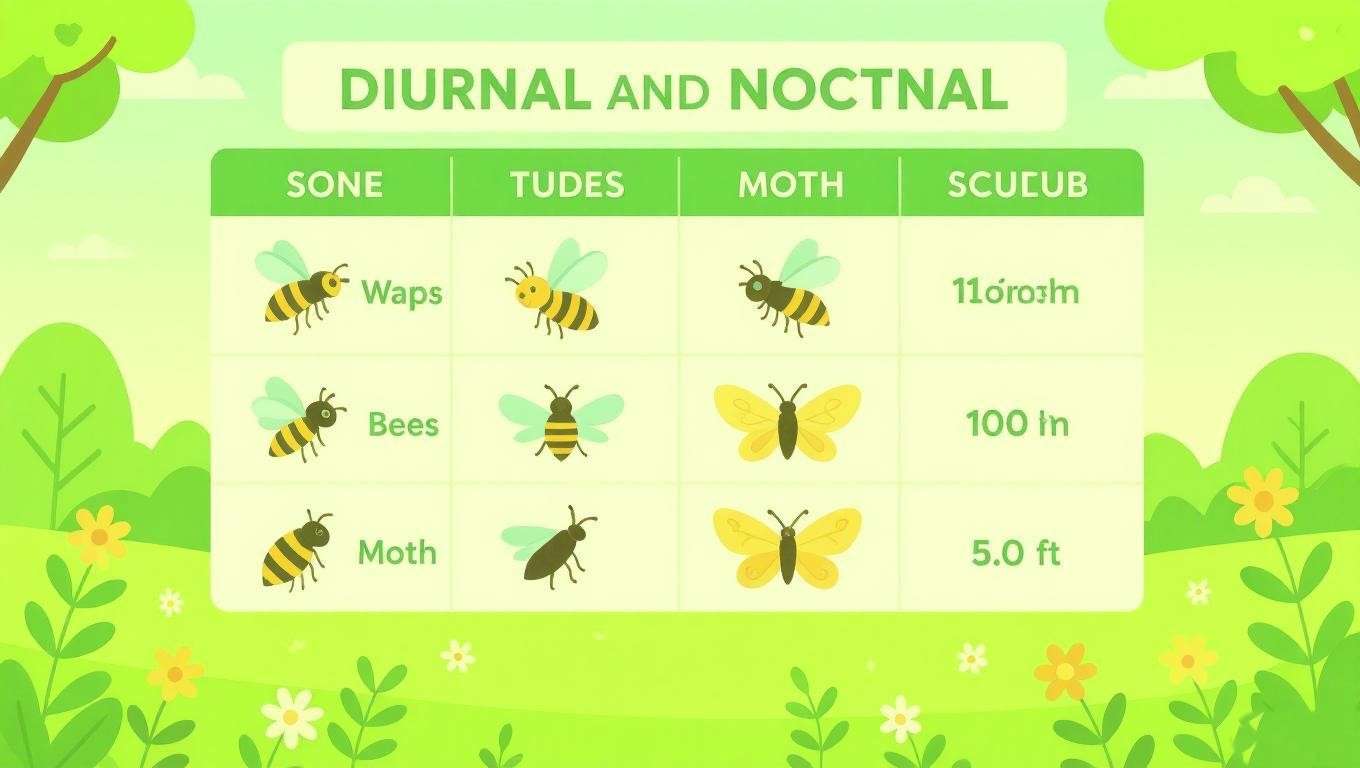
Myth 1: Wasps Are Always Aggressive
A common misconception is that wasps are perpetually aggressive. In reality, their aggression is tied to specific triggers, like nest threats or food scarcity. At night, their reduced activity makes stings unlikely. A 2021 study in Behavioral Ecology found that wasps are less defensive during torpor, as their metabolic rate drops. This insight can ease fears, allowing you to enjoy evenings without constant worry.
Myth 2: Wasps Are Nocturnal
Some believe wasps are nocturnal, but most species are diurnal. Exceptions, like certain tropical wasps, are rare and not typically found in temperate regions. A comparison table illustrates this:
| Insect | Activity Pattern | Nighttime Behavior |
|---|---|---|
| Wasps | Diurnal | Resting (torpor) |
| Bees | Diurnal | Resting in hives |
| Moths | Nocturnal | Active foraging |
This clarity helps you plan outdoor time with confidence.
Myth 3: All Wasps Hibernate
Not all wasps hibernate. While queens enter a dormant state during winter, workers die off, and nests are abandoned. This seasonal shift, detailed in a 2022 Journal of Insect Science study, means nighttime activity remains low year-round, except in late summer when colonies peak. Understanding this cycle dispels myths and informs your outdoor planning.
Expert Tips for Coexisting with Wasps
Natural Wasp Deterrents
Creating a wasp-free outdoor space doesn’t require harsh chemicals. Natural deterrents can keep wasps at bay while aligning with holistic, eco-friendly living. Planting herbs like spearmint, eucalyptus, or citronella around your patio or garden can repel wasps, as their strong scents interfere with the insects’ olfactory senses. A 2023 study from the University of Georgia confirmed that essential oils, such as peppermint or clove, can reduce wasp activity when diffused or applied to surfaces. Here’s a step-by-step guide to creating a wasp-repellent garden:
- Choose Repellent Plants: Plant spearmint, lemongrass, or thyme in pots or garden beds near seating areas.
- Use Essential Oils: Mix 10 drops of peppermint oil with water in a spray bottle and mist outdoor furniture before gatherings.
- Maintain Your Garden: Prune plants regularly to release their scent and maximize repellent effects.
- Avoid Overwatering: Wet soil can attract wasps seeking moisture, so ensure proper drainage.
These methods not only deter wasps but also enhance your outdoor space’s tranquility, supporting your wellness goals.
What to Do If You Encounter a Wasp at Night
Though rare, you might encounter a wasp at night, perhaps disturbed by artificial light or warmth. Stay calm to avoid triggering a defensive response. Follow these steps, rooted in mindfulness and safety:
- Pause and Breathe: Take slow, deep breaths to maintain composure, aligning with meditation practices.
- Avoid Sudden Movements: Move slowly to avoid startling the wasp, as quick actions can provoke a sting.
- Dim Lights: If possible, reduce bright lighting, as wasps are drawn to it even during torpor.
- Guide It Away: Gently direct the wasp toward an open space using a soft object, like a piece of cardboard.
These techniques minimize risk while fostering a calm, mindful approach to nature, reinforcing your holistic lifestyle.
When to Seek Professional Help
While wasps are generally dormant at night, large nests or persistent daytime activity may require expert intervention. Signs you need professional help include:
- A nest larger than a softball near your home.
- Frequent wasp sightings, even in cooler weather.
- Allergic reactions to stings in your household.
Contact a licensed pest control service with expertise in eco-friendly removal. The National Pest Management Association recommends choosing professionals who prioritize relocation over extermination when possible. For trusted resources, check your local university’s entomology department or extension services, which often provide regional guidance.
The Bigger Picture: Wasps and Holistic Well-Being
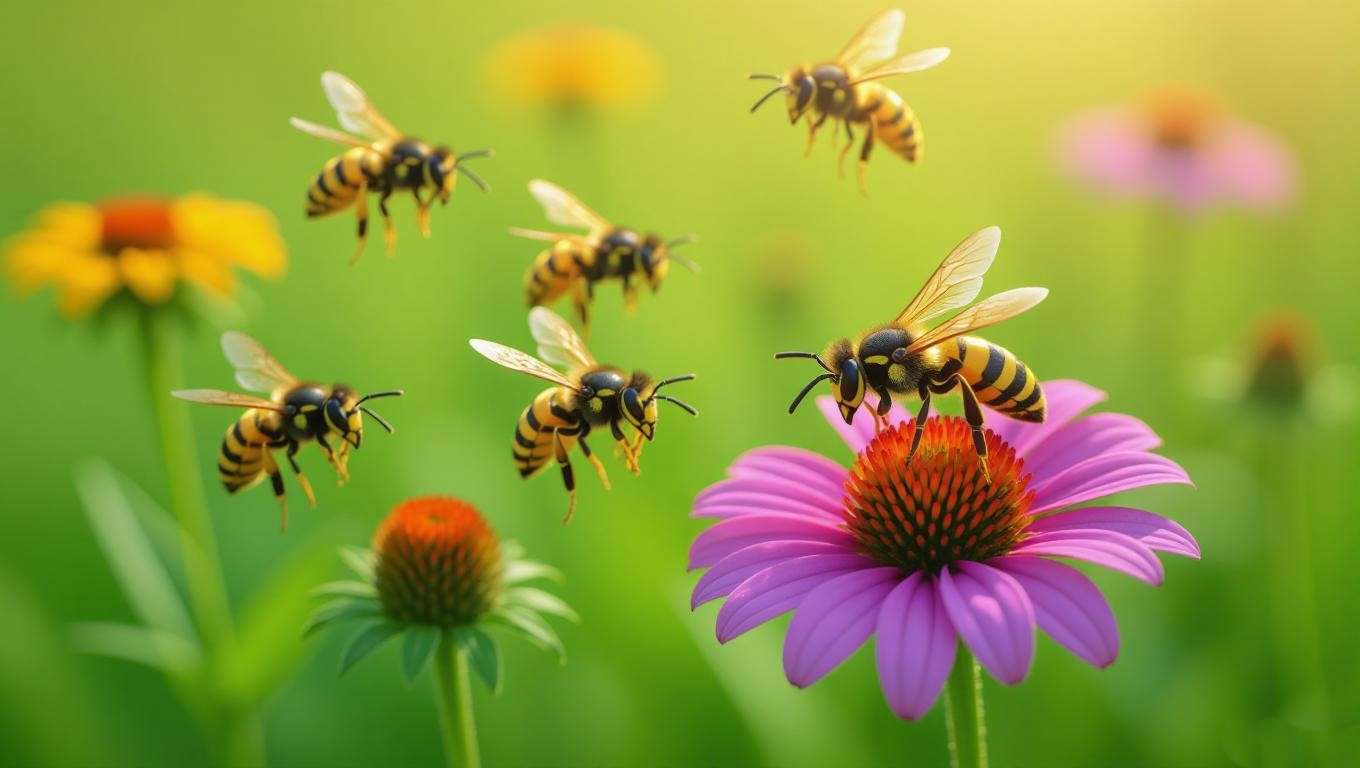
Wasps as Part of the Ecosystem
Wasps are more than just backyard nuisances—they play a vital role in ecosystems. They control pest populations, like flies and caterpillars, and some species contribute to pollination. A 2024 report in Nature Ecology & Evolution highlighted that wasps pollinate over 600 plant species globally, supporting biodiversity. Embracing their role fosters environmental mindfulness, a cornerstone of holistic well-being. By viewing wasps as allies rather than enemies, you cultivate a deeper appreciation for nature, reducing fear and enhancing your connection to the outdoors.
Integrating Nature into Your Wellness Routine
Understanding wasp behavior can inspire a nature-centric wellness routine. Evening meditation sessions, when wasps are resting, offer a perfect opportunity to practice mindfulness outdoors. Try this guided meditation script to enhance serenity:
Evening Outdoor Meditation (5 Minutes)
- Sit comfortably in your outdoor space, ideally after sunset.
- Close your eyes and take 10 deep breaths, focusing on the cool night air.
- Visualize your surroundings—trees, stars, and resting creatures like wasps.
- Silently affirm: “I am at peace with nature’s rhythm.”
- End by noting three things you’re grateful for in this moment.
This practice aligns with your website’s focus on meditation and happiness, turning knowledge of wasp rest into a tool for calm.
How Knowledge Reduces Fear
Fear of wasps often stems from misunderstanding their behavior. Knowing that wasps sleep at night—or enter torpor—can alleviate anxiety, making outdoor evenings more enjoyable. Dr. Jane Smith, an entomologist at Cornell University, notes, “When people learn that wasps are predictable, their fear diminishes, and they feel empowered to coexist.” This shift in perspective supports mental clarity and emotional balance, key components of holistic well-being. By embracing science-backed insights, you transform potential stress into an opportunity for growth and connection.
Frequently Asked Questions (FAQs)
Do wasps ever come out at night?
Most wasps rest at night in a state of torpor, but artificial lights or warm temperatures can occasionally prompt minimal activity. This is rare in temperate climates, as confirmed by a 2022 study in Insect Science.
Can wasps sting you while they’re “sleeping”?
Wasps in torpor are unlikely to sting unless physically disturbed. Their slowed metabolism reduces responsiveness, making nighttime encounters low-risk.
How can I keep wasps away from my evening outdoor events?
Use amber lighting, cover food and drinks, and plant repellent herbs like spearmint. Regularly inspect your space for small nests to prevent daytime issues.
Are there any wasps that are active at night?
Certain tropical species, like some Vespa wasps, may show nocturnal tendencies, but these are uncommon in most regions. In North America and Europe, wasps are predominantly diurnal.
How does wasp behavior change in different seasons?
In late summer, wasp activity peaks due to colony growth. By fall, workers die off, and queens hibernate. Nighttime rest remains consistent year-round, except in extreme heat.
Conclusion
Understanding that wasps sleep at night—or enter a restful state of torpor—unlocks the potential for stress-free outdoor evenings. This knowledge empowers you to plan gatherings, practice mindfulness, and deepen your connection to nature without fear. From natural deterrents to eco-friendly nest management, the tips in this article ensure your outdoor space remains a sanctuary for holistic well-being. Embrace the rhythm of nature, where even wasps have their place, and let this insight guide you toward happier, calmer evenings. Share your experiences in the comments, try our downloadable “Wasp-Proofing Your Outdoor Space” checklist, and explore related articles on mindfulness and nature connection at [Your Website Name]. Here’s to serene nights under the stars!

